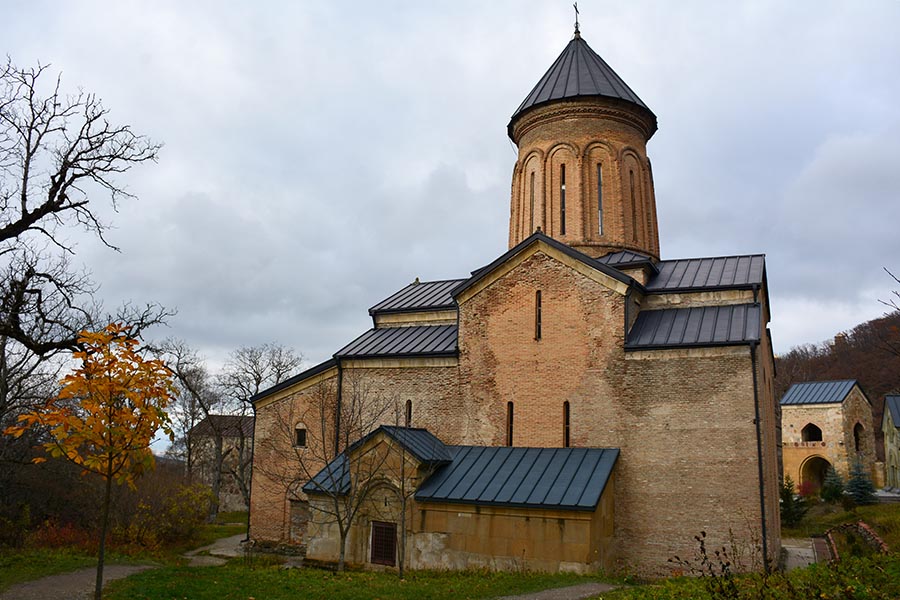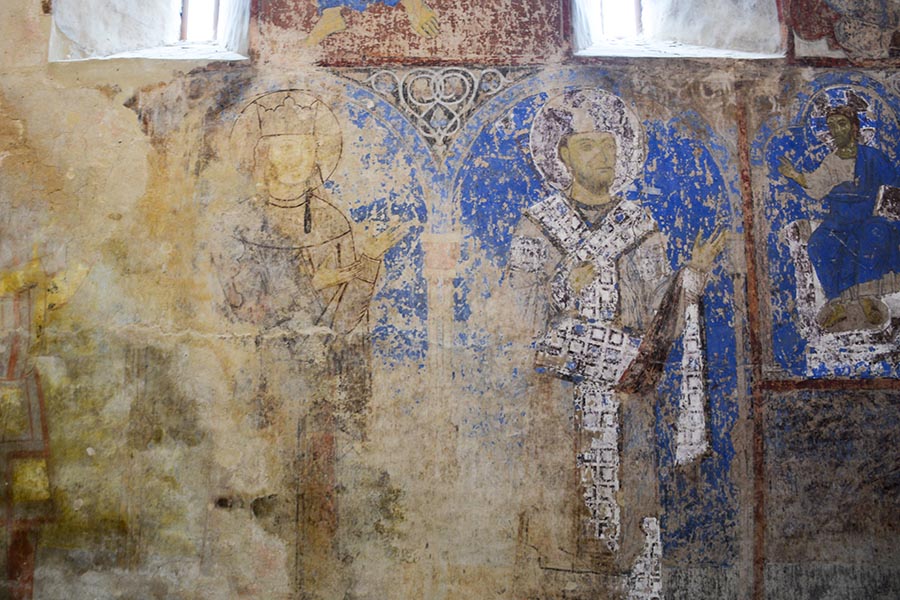
Kintsvisi Monastery near Gori is an Orthodox monastery in the Shida Kartli Region of Georgia which is best known for its astounding frescoes and unusual architecture. It served as an active monastery for nearly a millennium between the 10th-19th centuries, and following the dissolution of the Soviet Union in the early 1990s, monastic life at the hermitage was reinstated.
The Kintsvisi Monastery complex consists of a bell tower and three churches: Church of the Virgin Mary, St. George Church and St. Nicholas Church.
Church of the Virgin Mary
The oldest church of Kintsvisi Monastery is Church of the Virgin Mary. Presumably built in the 10th century, it is best known for its preserved fresco of a Hodegetria and Communion of the Apostles. Although all four walls of the church are believed to have once been painted in a similar fashion, centuries of decay and a partial collapse of the building have erased most traces of its former glory.
St. George Church
St. George Church is a small chapel next to the larger St. Nicholas Church. Built in the late Middle Ages, the church includes a hall built from chiseled stone blocks of varying sizes and window arches overlaid in brick. The apse stands out for its irregular shape and the manner in which it seamlessly blends with the sanctuary halls.
St. Nicholas Church
The youngest and most prominent cathedral of Kintsvisi Monastery, St. Nicholas Church was built in the 13th century during the height of the Georgian Golden Age. Unlike other buildings of the era, the church was constructed from brick and thus lacks the typical carvings found on most Georgian churches, with its cross-domed façade defined instead by two distinctive pillars and entrances on three sides.
What truly distinguishes St. Nicholas Church, however, are the unique 13th-century murals which fill its interior and are regarded as some of the most remarkable examples of medieval Georgian art.
Frescoes of St. Nicholas Church

The earliest frescoes of St. Nicholas Church were 13th-century masterpieces created by Anton Gnolistavisdze, a feudal lord who served in the Georgian Royal Court during the reigns of Giorgi III and Queen Tamar, the latter of whom also appointed him a bishop at Samtavisi Cathedral. A portrait of Gnolistavisdze himself is depicted inside the church alongside some damaged images of St. Nicholas, St. Nino and other Georgian Orthodox saints. Also from this era are unique depictions of Georgia’s rulers, including Giorgi III (1156–1184), Queen Tamar (1184 –1213) and Giorgi IV Lasha (1213 –1222). Above their portraits is the figure of an angel which is known as "Kintsvisi Archangel" and regarded as a symbol of medieval Georgian art. These frescoes are especially valued for their tinting created from lapis-lazuli, which at that time was a rare find.
The western walls of St. Nicholas Church were not painted until the 15th-17th centuries. They include a massive illustration of the Day of Judgment and a portrait of Zaza Panaskerteli, a prominent 15th-century prince and the country’s first recorded doctor who is known for his composition of the medical book Karabadini. Panaskerteli is also credited with renovating Kintsvisi Monastery in his day.
Visiting Kintsvisi Monastery
Kintsvisi Monastery sits on a hill in the Dzama Gorge and is well worth the hourlong drive from Gori. Although its stunning scenery and remote medieval churches are beautiful year-round, the colorful foliage of late autumn is particularly impressive. There are also hiking options in the area, including routes that lead through the forest to the secluded Bateti Lake.

